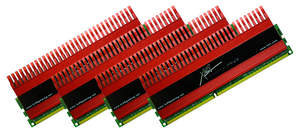Windows 8 Not Much Help For Depressed DRAM Industry
As we are seeing DRAM spot prices trading nearly record lows - a 4 Gb 4DDR3 chip can be purchased for as little as $1.75 - it appears that DRAM makers will not get much relief from the release of Windows 8.
While the release of a new Windows OS has traditionally created a double-digit jump in DRAM demand, that will not be the case this time, according to IHS iSuppli. The reason can be found in the fact that Windows 8 does not call for more DRAM in computers as previous Windows upgrades typically have, and Windows 8 itself is not expected to bring consumers out and convince them to buy a new PC just because there is a new Windows.
IHS said that global DRAM bit shipments are expected to increase by only 8 percent sequentially in the fourth quarter. This number already counts in the demand from smartphones and tablets, which are becoming increasingly important for DRAM makers. The demand will be about the same as it was in the fourth quarter of 2011, IHS said.
Windows 8 is, in this view, a big disappointment for the hardware industry already. IHS noted that Windows 3.1 caused DRAM bit shipments to increase by 29 percent, Windows 95 by 23 percent, Windows 98 by 40 percent, Windows 2000 by 49 percent, Windows XP by 41 percent, and Windows Vista by 26 percent. Windows 7 brought the number down to 18 percent. Windows 8 may hit a record low at 8 percent - and even that may be a rather optimistic forecast since much of the increase does not depend on Windows anymore, but on tablets and smartphones.
Contact Us for News Tips, Corrections and Feedback
Get Tom's Hardware's best news and in-depth reviews, straight to your inbox.

Wolfgang Gruener is an experienced professional in digital strategy and content, specializing in web strategy, content architecture, user experience, and applying AI in content operations within the insurtech industry. His previous roles include Director, Digital Strategy and Content Experience at American Eagle, Managing Editor at TG Daily, and contributing to publications like Tom's Guide and Tom's Hardware.
-
nieur why would anyone buy new PC just because new OS is available? on top of that it does not demand improved hardwareReply -
@rahulkadukar "chip" is referring to the actual chips on the PCB not the entire module just fyiReply
-
hp79 nebunwhat does a software company have to do with memory prices....I am a little confusedThe idea here is that assuming Windows being a dominant OS, had Windows 8 required more RAM than Windows 7, there would have been more demand for RAM. But since Windows 8 is even more efficient, it's not going to encourage people to buy more RAM. I think most people already have at least 4 GB in their system now.Reply -
ronch79 The jump in graphics quality and OS capability has improved markedly with past OSes. Today I think the improvement between successive OS releases grows smaller and smaller, so any big jump in RAM requirement is seen as sloppiness in part of the OS (and its code). Take Vista, for example, it was deemed inefficient (and yes, even if it's graphically much prettier than XP) because of its RAM requirements. MS had to go back to the drawing boards, clean up the code, and re-release it as Windows 7. Just my $0.02.Reply -
teodoreh 1st: You can't just increase the memory requirements without major leaps on services. You can't launch W8 requiring 8GB of RAM with no apparent reason. You need new more memory hungry applications to be written to say "you will need 8GB of RAM but, we will provide u with this new feature".Reply
2nd: If Windows 8 were as stupidly memory hungry as Windows Vista at their time (where most laptos were shipped with 512MB~1GB RAM) then that would hurt W8 adaptability as Vista.
3rd: The majority of current motherboards support 2~4 slots and 8GB~16GB of DDR3, and laptops usually do have 0~1 empty slots for upgrades.
4th: We are in the mid to end of life of DDR3 and the prices are extremely low.
5th: Who cares? Semiconductor companies should focus on the SSD wild race. Magnetic media, WD, Toshiba and Seagate will soon disappear from the market, and someone will have to fill the gap. -
BoredErica I don't like Windows 8, but this article doesn't make sense to me. Windows 8 isn't a ram-hungry mess, and thank god for that. Why would ram decrease a lot if the OS is relatively light?Reply -
Someone Somewhere rahulkadukar4 Gb 4DDR3 chip can be purchased for as little as $1.75Reply
Where ?
That's a 4 gigabit chip, or 512MB. Plus it's only the actual chip, not the PCB, assembly, other chips for SPD etc. It's also probably the price for buying thousands of them -
unksol Reply9420565 said:4 Gb 4DDR3 chip can be purchased for as little as $1.75
Where ?
That's the low end ones, and that's Gb. You need 8 of them to make 4 GB. Plus the PCB, spreaders, manufacturing and other parts.
Edit: beat by "someone" by 51 seconds lol
